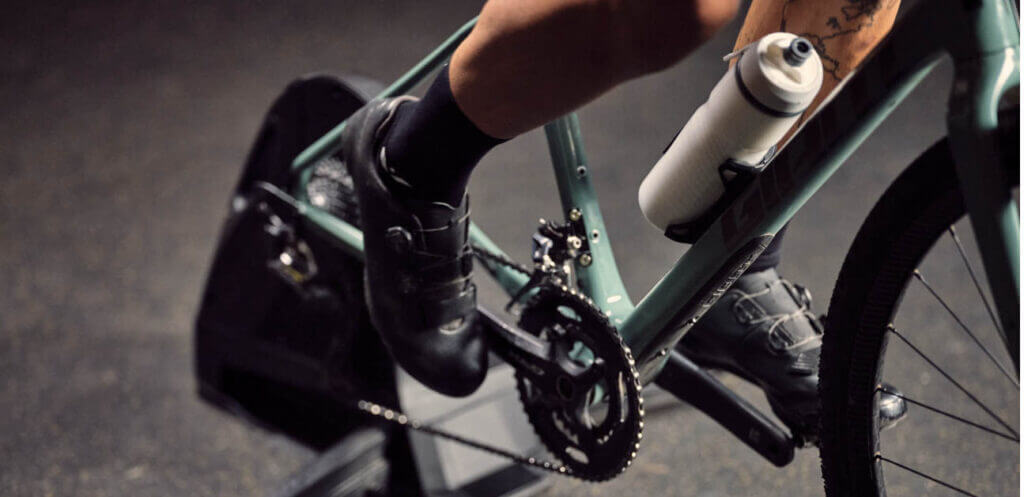Five Indoor Drills to Make you a Faster Climber

Growing your fitness isn’t the only way to become a faster climber—technique and form also play an essential role in your ability to climb efficiently. You can improve your climbing-specific skills with on-the-bike drills that target technique, form, strength, and efficiency.
Drills to Climb Faster
While fitness is an essential part of climbing, it’s not the only thing that goes into a climb. Your cadence, form, technique, and efficiency all play an important role in your ability to climb quickly. Fortunately, much like your fitness, all of these abilities are highly trainable. One of the most effective ways to improve your climbing abilities is with climbing-specific drills. Drills are on-the-bike exercises that use technique and repetition to target key skills and proper technique.
Among the drills available to cyclists, there are a few that are particularly relevant for climbing. These are drills that enhance pedaling efficiency, cadence, force, and body position. If you’re interested in improving these abilities we recommend adding a combination of endurance spinning drills, hill simulations, force intervals, standing drills, and power sprints to your climbing training.
Indoor Drills for Climbing
- Endurance Spinning Drills
- Hill Simulations
- Force Intervals
- Standing Climbing Drills
- Power Sprints
1. Endurance Spinning Drills
On longer sustained climbs, a higher cadence can be significantly more efficient. Pedaling at a high cadence requires less force, which puts less strain on your muscles. When you can turn the pedals with less strain on your muscles, it conserves energy and broadens your ability to sustain your aerobic power. Endurance spinning drills are designed to gradually improve your ability to spin a high cadence by incrementally challenging your current output.
To integrate speed endurance intervals into your workout, you’ll aim to maintain the power target prescribed in your workout while riding at an rpm higher than your usual cadence. This is typically 3-5 rpm above the cadence you usually ride at. If you don’t have a cadence sensor, you can do this drill by feel, pedaling just a bit more quickly than you’re used to. When you integrate these intervals into your workout the intervals should be at least five minutes long.
2. Force Intervals
When a steep climb requires you to generate a lot of power at a very low cadence it tends to put a bit of extra pressure on your knees. Force intervals address the unique demands of climbing at a low cadence by improving the resilience of your connective tissue and providing you a chance to control the lateral movement of your knees; especially at the top of the pedal stroke.
To complete this drill, find a gear that still allows you to hit your target power while spinning at a cadence between 50 and 60 rpm. When you’re doing this drill focus on the top and bottom of your pedal stroke by kicking over the top and pressing your foot downwards, and try to minimize any lateral movement in your knees. As noted earlier, high force/ low cadence exercises tend to put some strain on your knees. While this isn’t an issue for most athletes, if you have any pain or issues with your knees, feel free to skip this drill altogether and focus on knee movement during a less strainful workout.
3. Standing Climbing Drills
When you reach a short climb standing and pedaling out of the saddle can be the most effective way to reach the top. When you stand and pedal, you’re able to use the anaerobic power from your upper body to output more power into the pedals. With that said, the physical demands and complex techniques make it inherently less efficient. You can drastically improve your efficiency pedaling out of the saddle by integrating standing drills into your workouts.
To complete a standing drill, wait until you reach an interval that allows you to maintain the power target out of the saddle. When you’re ready to start the interval exit the saddle and quickly wind up. This drill is all about control and technique, so focus on winding up while maintaining good form. Remember that the transition from seated to standing is where energy, power, and momentum are often lost, so try to focus on moving in and out of the saddle as smoothly as possible whenever you complete these drills. Initially, these drills should only be about ten seconds long. As you progress and improve, however, you should incrementally increase the amount of time you spend out of the saddle.
4. Hill Simulations
Hill simulations are Sweet Spot and Tempo intervals performed with a raised front wheel. By raising your front wheel three to six inches above your rear wheel you can emulate the slight demands that different gradients place on body position. While there’s no conclusive evidence that this drill engages the muscles differently than traditional indoor intervals, the opportunity to dial in body position is valuable. Much like improving your cadence will conserve energy by helping to prevent muscular strain, creating a good, relaxed body position can prevent discomfort and wasted energy for a more efficient climb.
To perform these drills find a sturdy platform that you can use to securely raise your front wheel three inches above your rear wheel, for the duration of the workout. As you grow accustomed to completing these types of drills then you can incrementally increase the height of the front wheel. With that said, we don’t recommend exceeding a six-inch difference between your front and your back wheel.
When you start these intervals focus on the position of your back as well as any tension you might be holding in your back and your shoulders. Are you maintaining a flat back? Are your shoulders and arms relaxed? Little adjustments like this can make a big difference on a long climb. Once you’ve found a good body position you can shift your focus to your pedal stroke. Try to focus on the top and back quadrants of your pedal stroke. Focus on lifting your knees upward and then gently kicking your feet forward. When you’re seated try to maintain a cadence above 80rpm. If you attempt any of these drills standing, 75 rpm is a good goal.
Advanced Hill Simulations
Advanced hill simulations are the same drills performed during Threshold workouts. We only recommend completing advanced hill simulations when you’ve established threshold fitness, and grown comfortable with the demands of riding with an elevated front wheel during your tempo and sweet spot workouts.
5. Strength Sprints
Similar to force intervals, strength sprints are drills designed to help you turn over a big gear and quickly recruit as many muscle fibers as possible. These drills are particularly effective for athletes who want to be able to repeatedly conquer challenging short and punchy climbs. When you practice this drill you’ll begin at a near stop. Your goal is to pedal as gracefully as possible from this near stop in twelve pedal strokes, without exceeding 90 rpm.
While this drill may emphasize strength, its main focus is still proper form. Focus on maintaining the form that you’ve been practicing in the other drills. As you stand up to pedal, hold onto your handlebars and drive each foot as hard as you can without compromising technique. For full detail on proper sprinting form read: Sprinting 101: How to Improve Your Cycling Sprint Technique.
Adaptive Training
Get the right workout, every time with training that adapts to you.
Check Out TrainerRoadFive Tips for Indoor Cycling Drills
While you won’t need much to begin integrating drills into your workouts, there are a few additional things to keep in mind when you add drills to indoor cycling workouts. You can follow these tips to help ensure success during your indoor cycling drill sessions.
1. Start With Lower Intensity Workouts
Like anything new, drills have a learning curve to them. When you first begin, it can feel a bit awkward or unnatural to integrate drills into your workout. This comes with time! Start by integrating some of the simpler drills, like endurance spinning drills, into your low-intensity endurance workouts. As you grow more comfortable with drills you can begin to integrate more dynamic drills into your higher intensity workouts.
2. Prioritize Quality over Quantity
The purpose of indoor drills is to progress your technique and reinforce good form. If you’re feeling fatigued, or the workout is pushing up against your physical limits, it might not be a good time to add drills. Add drills when you have the mental bandwidth to take on an additional task, and the focus to reinforce proper technique. If you’re doing drills and you feel yourself losing focus or struggling to maintain the right form, switch to an easier drill or resume pedaling normally. It’s better to complete a fraction of the drill at the highest quality than the whole drill at a lower quality.
3. Add Drills When they Compliment the Workout
Some workouts are better suited for certain drills than others. The best time to add a drill is when the drill compliments the structure and objective of your scheduled workout. For example, power sprints pair really well with a workout that integrates Anerpobic capacity intervals or sprints. When you’re feeling up for it, all you have to do is line your strength sprint drills up with the high-intensity intervals during that workout.
4. Enable Workout Text
While you’re welcome to integrate as many drills as you’d like at your own discretion, some workouts are already set up with drills through workout text. Workout Text is a feature in TrainerRoad that provides information and instructions during the workout. Not every workout has workout text, and not every workout with workout text incorporates drills. However, when they do it can be a simple and easy way to get some drills into your workout.
5. Adjust Your Resistance Control Accordingly
If you’re training with a smart trainer there are certain drills that aren’t compatible with Erg mode. Specifically, if you’re using a smart trainer and you have it in Erg mode, you may want to turn it to resistance mode for drills that impact cadence and power. For example, drills like endurance spinning drills and force intervals can be challenging to do in ERG mode.
